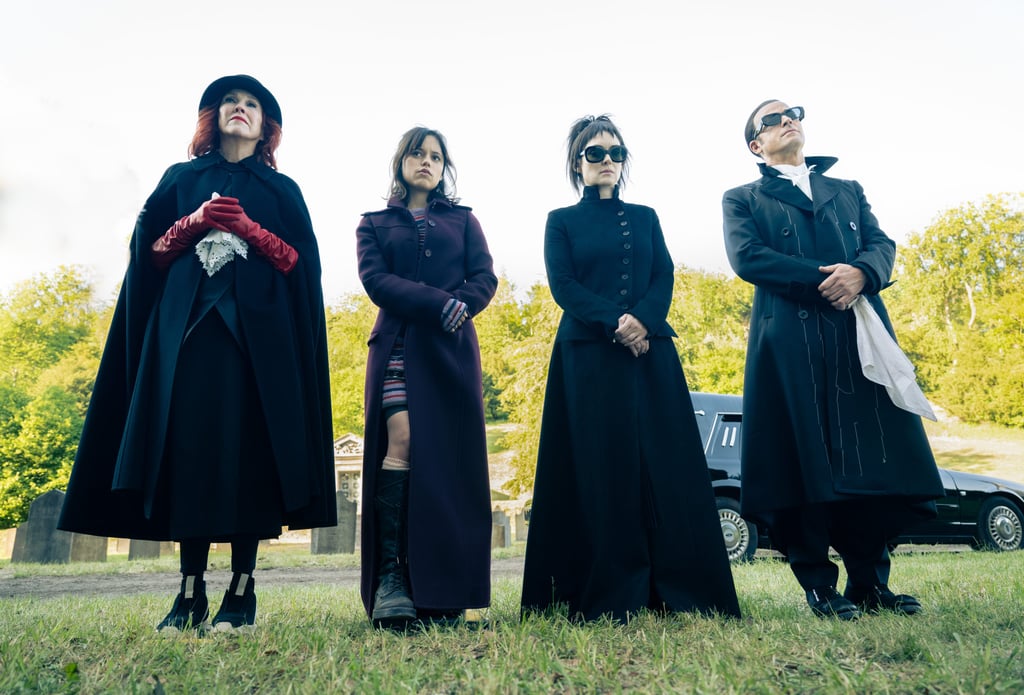Entertainment
Next year's Oscars have a surprising original song contender: Kristen Wiig

“‘Talented musician’ might be a little strong” to describe Kristen Wiig, the “Saturday Night Live” veteran demurs when complimented about her chops. So another label will have to do.
How about “Oscar-nominated musician Kristen Wiig”?
It’s now a distinct possibility: Netflix will campaign for Wiig and co-writer Sean Douglas in the original song category for the folksy comic ditty “Harper and Will Go West,” from the forthcoming documentary “Will & Harper,” the company confirmed exclusively to The Times. The film, which premiered at this year’s Sundance Film Festival, arrives on Netflix on Sept. 27 after an Oscar-qualifying theatrical run.
“Will & Harper” follows former “SNL” star Will Ferrell and his friend, longtime “SNL” writer Harper Steele, on a cross-country road trip after Steele comes out as a trans woman. Along the way, they meet trans people carving out a life in small-town America, discuss the challenges Steele faced pre- and post-transition and much more. They also park their classic Jeep Wagoneer to conscript Wiig, via FaceTime, to write a “tear-to-your-eye, fun, uptempo, jazzy with a little country” theme song for their journey.
The resulting number, filmed in Wiig’s backyard and accompanied by ukulele and saxophone, combines humor — the opening verse rhymes the song’s title with the phrase “a couple brand new breasts” — and heartfelt emotion (“A friend is a friend is a friend … ’til the end”) in a way that reflects the film as a whole.
“It was kind of like this funny thing when they called me saying they wanted it to be all these different types of music,” laughs Wiig, who studied piano and sang in church and school choirs as a child, before taking up the ukulele in recent years. But instead of a full-on spoof, she, Douglas and the film’s director, Josh Greenbaum, decided to “steer away from something too jokey”: “We just wanted a nice song for the two of them.”
Songs with humorous elements have previously broken into the Oscars’ original song category. The film academy famously nominated the satirical, profanity-laden “Blame Canada” from “South Park: Bigger, Longer & Uncut” in 2000 and has more recently tapped the likes of “Husavik,” from the 2020 comedy “Eurovision Song Contest: The Story of Fire Saga,” and “I’m Just Ken,” from last year’s blockbuster “Barbie.” The most recent winner, also from “Barbie,” was “What Was I Made For?” by Billie Eilish and Finneas O’Connell.

Movie Reviews
‘Maria’ Review: Angelina Jolie’s Maria Callas Suffers at a Chilly Distance in Pablo Larraín’s Biopic

In Jackie and Spencer, Pablo Larraín removed any trace of starch from the historical bio-drama to examine, with penetrating intimacy, famous women in moments of extreme emotional distress played out in the glare of a global spotlight. Intimacy is the key factor lacking in the third part of the gifted Chilean director’s unofficial trilogy, Maria. Starring Angelina Jolie as revered operatic soprano Maria Callas over the final week of her life in Paris, the movie is like a glittering jewel in a glass showcase, inviting you to look but not touch.
That doesn’t mean it’s uninvolving or that Jolie’s technically precise interpretation isn’t impressive. But there’s a meta collision between a star whose celebrity has long eclipsed her acting achievements, making it all but impossible for her to disappear into a character, and a subject who constructed an imperious persona for herself, performing even when she wasn’t on a stage.
Maria
The Bottom Line Sings but misses the high notes.
Venue: Venice Film Festival (Competition)
Cast: Angelina Jolie, Pierfrancesco Favino, Alba Rohrwacher, Valeria Golino, Haluk Bilginer, Stephen Ashfield, Valeria Golino, Kodi Smit-McPhee, Vincent Macaigne, Lydia Koniordou, Aggelina Papadopoulou
Director: Pablo Larraín
Screenwriter: Steven Knight
2 hours 3 minutes
Doubling down on icons brings a lot of weight for a role to bear. It results less in a kinship between actor and character than a twofold remove — an exercise in character study, a tad glacial and distancing, rather than a flesh-and-blood portrait.
The movie is beautifully crafted, of course, graced with sumptuous visuals from the great Ed Lachman. The cinematographer captures the City of Light in 1977 in soft autumnal shades highly evocative of the period and shifts into black-and-white or grainy color stock for Callas’ many retreats into memory. Lachman, who was Oscar-nominated for his breathtaking chiaroscuro work on Larraín’s last feature, El Conde, shot Maria using a textured mix of 35mm, 16mm and Super 8mm, along with vintage lenses.
The DP’s outstanding work enhances the refined contributions of production designer Guy Hendrix Dyas and costume designer Massimo Cantini Parrini. The latter’s stunning gowns include chic ensembles worn at public occasions and exquisite costumes for Callas’ famed stage roles, some of which the singer is seen burning as she separates herself from the past.
“I’m in the mood for adulation,” Callas tells a Paris waiter when he suggests she might be more comfortable inside than at an outdoor café table. “I come to restaurants to be adored.”
Larraín and screenwriter Steven Knight, who previously penned Spencer, comply to a degree. Their film is an act of mournful worship for a diva who seems almost too arch, too cloaked in affectation to read as a vulnerable human being — even as her body is shutting down and she’s racked with insecurities about her voice while planning to sing again, more than four years after she last performed. Often, it feels like the filmmakers are scrutinizing Callas with the disorienting effect of a magnifying glass.
The balance doesn’t seem quite right when you feel more for the loyal household staff who love and protect her than you do for the woman lying dead on the carpet by the grand piano. That image opens the movie, preceded only by a slow pan around Callas’ stately apartment.
Knight employs the pedestrian framing device of an interview, with a TV arts reporter and cameraman coming to Maria’s home. The journalist’s name, Mandrax (Kodi Smit-McPhee in a thankless role), is a tipoff that he’s a product of Maria’s mind given that it’s also the name of the medication on which she’s most dependent — more commonly sold as Quaaludes in the U.S.
In what seems a ritual maintained for some time, Maria’s hyper-vigilant butler, Ferruccio (Pierfrancesco Favino), removes the pills from her dressing table and later from the handbags and coat pockets where she has stashed handfuls of them around the room. She has also stopped eating for days at a time, feeding meals prepared by her housekeeper Bruna (Alba Rohrwacher) to her poodles.
She becomes peevish about the dire warnings of her medic, Dr. Fointainebleau (Vincent Macaigne), that her heart and liver are completely shot and that the stress of attempting to perform plus the meds she would need to get through it risk killing her.
The dominant thread becomes not that grim final week, punctuated by abortive rehearsals with a gently coaxing accompanist (Stephen Ashfield), but the singer’s mental forays into her past, from her unhappy childhood with an exploitative mother (Lydia Koniordou) through her love affair with Aristotle Onassis (Haluk Bilginer), whose aggressive charms instantly shoved her husband to the sidelines. Since the Greek shipping magnate eventually left her for Jackie Kennedy, there’s a satisfying full-circle completion with the subject of Larraín’s first film in the trilogy. But don’t expect a cameo from Jackie star Natalie Portman.
Maria’s memories are additionally crowded with her triumphs in the world’s most prestigious opera houses — Covent Garden, The Met, La Scala — flooding the movie with glorious music. The naked emotionality and piercing tragedy of the immortal operatic heroines is a poignant fit for Callas’ end-of-life story and a useful counterpoint to her studied poise and aloofness in this interpretation. The power of work by Verdi, Puccini, Bellini, Donizetti, Catalani and Cherubini goes a long way toward delivering the pathos that often seems muted by Larraín’s approach.
Passages from some of the most celebrated classical operas effectively supplant the role of a score. The soul-stirring choice of musical bookends for the film starts with Desdemona’s supplicant prayer, “Ave Maria,” from Otello, and closes with “Vissi d’Arte” from Tosca, in which a woman who lived for art and love feels abandoned by God. Opera enthusiasts will find much here to savor when the movie drops on Netflix at a date to be determined.
Commendably, Jolie undertook more than six months of rigorous vocal training for the part, also working on breathing and posture alongside specifics like accent. The singing we hear in Maria is a synthesized mix of star and subject. Arias from her prime are predominantly Callas recordings, but her voice in the 1977 scenes, older and rustier after years of vocal strain and a long absence from the stage, blends in a significant amount of Jolie. Neither lip-syncing nor karaoke, it’s a more intricate hybrid.
A number of striking moments use music to show memory and fantasy bleeding into Callas’ diminishing hold on reality. For instance, Maria strolling through the city with the Eiffel Tower in the background, in her mind marshaling a crowd of everyday Parisians singing the “Anvil Chorus” from Il Trovatore; or a full orchestra on the steps of one of the French capital’s grand historic buildings, playing in the rain while a throng of costumed geishas perform the “Humming Chorus” from Madama Butterfly. That ineffably moving passage of music, representing Butterfly’s calm vigil as she waits for Pinkerton’s return, adds emotional heft to the tragedy looming in Maria’s life.
Conflict surfaces when a music reporter for Le Figaro pulls a dirty trick and then confronts Maria outside the rehearsal auditorium with the view that her voice is irreparably ragged. But Knight’s script doesn’t capitalize on this as a moment of self-reckoning, instead limiting the scene to a distressing invasion of privacy.
The movie aims to depict a celebrated woman, whose life has been as much about sacrifice as reward, seeking to take control, to look back and see the truth as death approaches. But its moments of illumination are hazy. There’s little that comes close to the compassion and insight Larraín brought to his portraits of Jackie Kennedy and Princess Diana, even though it’s very much of a piece with those movies.
The tenderness of a scene in which Maria’s sister (Valeria Golino) urges her to put her troubled childhood behind her (“Close the door, little sister”) inadvertently points up how few opportunities we are given to get on comparably intimate terms with the protagonist.
In fact, the most heartbreaking moment for me came at the end, when the film returns to the day of Callas’ death from a heart attack, aged just 53. A high-pitched shriek that at first sounds like some strangled note from an aria is revealed to have come from one of her poodles, the dog’s cry of anguish becoming a loud expression of the hushed sorrow shown by Ferruccio and Bruna (Favino and Rohrwacher are both wonderful) as they reach for each other’s hand for comfort.
Still, Maria is a far more daring and unconventional take on the final chapter of the legendary soprano’s life than Franco Zeffirelli’s boilerplate 2002 biopic, Callas Forever, starring Fanny Ardant. And Larraín’s film becomes retroactively more affecting when the lovely archival images of Callas over the end credits, full of vitality at the peak of her career, widen the perspective on her sad, accelerated decline.
Movie Reviews
Beetlejuice Beetlejuice: Tim Burton revives his fantasy comedy

Lydia, a psychic mediator with her own ghost-hunting TV show, must return to Winter River to bury him. The quaint town where she grew up, it’s also the place where she encountered Michael Keaton’s afterlife spook Beetlejuice as a teenager.
Now she senses the quip-heavy ghoul is back and out to cause trouble. Joining her in Winter River is her oily manager-boyfriend Rory (Justin Theroux), her distraught mother (Catherine O’Hara) and her daughter Astrid (Jenna Ortega), a grouchy teen who refuses to believe in ghosts.
Meanwhile, Beetlejuice is terrified: his vampish, soul-sucking ex-wife Delores (Monica Bellucci, excellent) is on the warpath, having stapled her dismembered body parts back together.
With Halloween approaching, Beetlejuice is desperate to cross over into the real world – although the rules dictate that for that to happen, someone must say his name three times. The film doesn’t truly get going until he appears and Burton whisks us into the colourful afterlife.
There we will even encounter Charles, or at least the bottom half of him, fresh from his shark attack (presumably Burton is alluding to the fact that Jeffrey Jones, who played the role in the original, is persona non grata in Hollywood after being charged with soliciting a minor to pose for nude photographs back in 2003).
Led by an enthusiastic Keaton, who slips effortlessly back into his character’s dusty black-and-white striped suit, Beetlejuice Beetlejuice is more a film of moments than a coherent whole.
There is some lovely animation, giant Sandworms no less, integrated into the action, although it is not that clear why. There is a funky, 1970s-style Soul Train that takes people to the Great Beyond. And there is a whole lot of lip-synching going on, including “MacArthur Park”, the song made famous by Richard Harris.

It’s all a bit of a grab bag, with a plot nearly derailed by duff characters (like Willem Dafoe’s undead actor-detective) and pointless plot lines (Delores’ pursuit of Beetlejuice amounts to very little).
Entertainment
Meet Fuerza Regida, the hardest-working act in música Mexicana

What a difference two years can make.
In March 2022, Fuerza Regida embarked on a guerilla marketing campaign to promote an upcoming show at the Toyota Arena in Ontario, Calif. The San Bernardino-based quintet had already reached the top of Billboard’s U.S. Regional Mexican chart twice with 2019’s “Del Barrio Hasta Aqui” and 2020’s “Adicto,” two albums full of corridos tumbados, or trap corridos, which blend elements of traditional Mexican music— requinto guitars and a brass rhythm section— with hip-hop-like lyrics in Spanish about trapping, drug dealing and hustling. Despite the success, there were still plenty of unsold tickets left. Equipped with a megaphone, the band members’ instruments, a camera crew and a desire to see every seat filled for what would be a hometown concert, Fuerza Regida showed up unannounced at nearby Arroyo Valley and San Bernardino high schools and performed a quick set for students before moving on to the Ontario Mills mall, where it regaled unsuspecting shoppers.
But what created the biggest buzz from this traveling road show was the band’s final impromptu performance, which took place in the middle of the westbound 10 Freeway, right in front of the Toyota Arena. In a video clip posted to Fuerza Regida frontman Jesús Ortiz Paz’s TikTok account, we see the band’s caravan of vehicles block all five lanes as it plays a banda rendition of “El Muchacho Alegre,” a song popularized by legendary mariachi singer Pedro Infante. The stunt went viral, accruing millions of views and thousands of comments, many of them admonishing Fuerza Regida for bringing traffic to a standstill while others praised the members for their ingenuity.
By the day of the concert, every ticket had been sold.
“Back then, we would have to pull up [to a city] early to promote because we weren’t selling out like that. Thank God we don’t have to do that anymore,” Ortiz Paz, better known as J.O.P., says in between taking bites of baby carrots and hummus.
It’s a mid-July afternoon and I’m sitting with the 27-year-old singer and his entourage of at least a dozen people at a fast-casual Mediterranean restaurant in downtown Culver City, an hourlong pit stop in a day crammed with interviews to promote “Pero No Te Enamores,” Fuerza Regida’s eighth studio album (released July 25 on Rancho Humilde Records and Street Mob Records). Before speaking with The Times, J.O.P. joined Apple Music DJ Zane Lowe to record an episode of the streamer’s “New Music Daily” radio show. After lunch, it was off to Burbank to be interviewed by DJ Bootleg Kev for his syndicated hip-hop program. In a few days, J.O.P. and the rest of the band — requinto guitarist Samuel Jaimez, guitarron player Khrystian Ramos, tubist José Garcia and tololoche player Moises Lopez — would fly out to Dallas to resume a nationwide arena tour that has sold out most dates and will culminate with two shows at Inglewood’s Intuit Dome in mid-November.
Fuerza Regida’s requinto guitarist Samuel Jaimez, from left, guitarron player Khrystian Ramos, lead singer Jesus Ortiz Paz, tubist José Garcia and tololoche player Moises Lopez.
(Courtesy of Fuerza Regida)
“We’re doing just English media today. We’ve never really done anything with that market before,” J.O.P. says with a hint of satisfaction noticeable in his voice.
That the English-language music press has taken an interest in covering the release of “Pero No Te Enamores,” an album recorded in Spanish, is a testament to the rising popularity of música Mexicana in the U.S. and Fuerza Regida’s role in its growth. Once considered niche, it has been pushed into the mainstream on the heels of the pandemic by a bevy of acts who built their audiences on YouTube and TikTok before conquering the streaming services; according to entertainment data analysis company Luminate, Latin music was the fastest-growing genre in the U.S. on platforms like Spotify and Apple Music during the first half of 2024 thanks in large part to música Mexicana. The subgenre is hardly a cultural import. Many of its young stars and their ever-growing fan bases are based on this side of the border.
“I feel like people in the U.S. identify themselves with Fuerza Regida,” J.O.P. says. “All the no sabos, all the pochos, they know our culture is a different culture being born over here [rather] than over there.”
Música Mexicana’s dominance is most apparent in Southern California, home to the country’s largest Mexican American population. As of this writing, 14 of the 25 songs listed on Apple Music’s daily trending chart for Los Angeles belong to the genre, sharing space with the likes of pop “it” girl Sabrina Carpenter and Kendrick Lamar’s epic diss track “Not Like Us.” Of these, six are Fuerza Regida songs.
The band got its start in 2015 by playing covers at parties and local venues in San Bernardino, and the rollicking good times haven’t stopped since —its concerts are notoriously boozy, boisterous affairs. Fuerza Regida’s specialty is making earworms meant to be played loudly, whether it be “Radicamos en South Central,” its first hit, a corrido tumbado from 2018 about building a drug empire brick by brick; “Bebe Dame,” a romantic cumbia recorded with Tex-Mex act Grupo Frontera in 2022; or “Tu Name,” a scornful rebuff released earlier this year about moving on and forgetting someone by sleeping with other women.

Besides its ability to make infectious party anthems, Fuerza Regida’s success can be attributed to its prolificness. Over the last two years, the group has released four albums and one EP, all of which cracked the Billboard 200 top albums chart for all genres. When not recording, Fuerza Regida has been on the road, playing close to 100 shows over the same period.
“I was a businessman before I was an artist,” says J.O.P., who oversees the creative direction of Fuerza Regida, of his entrepreneurial approach to the music industry as the diamond-encrusted logo of Street Mob Records dangles from his neck. Not content with just being a musician, he founded the independent music label in 2019. Since then, he’s signed Calle 24 and Chino Pacas, two of the most promising artists in música Mexicana.
“My dad works in construction and he likes what he does. He’s been doing it for 35 years. He doesn’t have to work anymore but he still goes in because he enjoys it. I’m the same way. I go to the office, put in 14-hour days, go home and I’m happy,” he added.
“Pero No Te Enamores” is Fuerza Regida’s most ambitious project to date, one that puts the pliancy of musica Méxicana to the test. Throughout its history, Mexican music has borrowed from and incorporated other genres into its fold — the accordion, a staple of conjunto and norteño, was first introduced to the country in the late 19th century from Czech and German immigrants through polkas; cumbia arrived from Colombia in the 1940s. With its latest, Fuerza Regida is adding electronic dance music into the mix.
“Jersey corridos, make sure you put that in there, “ J.O.P. says, giving a name to the fusion of Jersey club, drill, house music and corridos found in the album.
Fuerza Regida first dipped its toes in the EDM waters last year with “Harley Quinn,” an uptempo collaboration with DJ Marshmello that’s heavy on the horns — the single, off of “Pa’ Las Baby’s y Belikeada,” peaked at No. 40 on Billboard’s Hot 100. With “Pero No Te Enamores,” the band dives headfirst from the deep end of the pool. To make the 15-track record, Fuerza Regida enlisted producers Gordo (who worked on Drake’s 2022 album “Honestly, Never Mind”) and Synthetic (he produced Lil Uzi Vert’s 2023 single “Just Wanna Rock”), and collaborated with EDM heavy hitters DJ Afrojack and Major Lazer.
The hybrid sound of Jersey corridos is most apparent in tracks like “Bella” and “Secreto Victoria,” which seamlessly blend guitar instrumentations with catchy dance beats. In some cases, Fuerza Regida abandons the música Mexicana sound altogether — “Nel,” the album’s lead single, is closer to reggaeton.

“The album is all summer vibes, very EDM, but it doesn’t lose the lingo of Fuerza — the album is all Fuerza’d out,” J.O.P. says. Lyrically, “Pero No Te Enamores,” which translates to “but don’t fall in love,” comes from the perspective of someone who’s having too much fun being rich, famous and single — a recurring theme in the band’s extensive body of work.
If fans were upset about the experimental turn taken with the record, that dissatisfaction was not reflected on the charts. Within 24 hours after its release, “Pero No Te Enamores” jumped to the No. 1 spot on Apple Music’s all genres list. The following week, it debuted at No. 25 on the Billboard 200.
Despite the success of the record, J.O.P. says the band is not done with corridos.
“I love Jersey club, so when we decided to make a dance album, we knew it was going to be this. I don’t want to make different types of music throughout my career. I wanted to do this album and then go back to my original stuff,” he said, hinting that the next album was already in the works.
Nor is J.O.P. done with taking a do-it-yourself approach to promoting Fuerza Regida’s music. On the day of the release of “Pero No Te Enamores,” the frontman and his crew hosted two free listening parties in the Los Angeles area. The first was an afternoon flash pop-up at a beachside mansion in Santa Monica where hundreds of people showed up after the location was posted on the band’s Instagram account. Later that night, the party moved over to Boyle Heights nightclub Don Quixote for an event sponsored by Spotify that included free drinks and tote bags with the album’s logo — a crossed-out heart— screenprinted on the spot. These functions, J.O.P. says, are a way to thank their core fan base.
“We like to do something for the people that can’t really afford a ticket to our shows. We have to do our shows, that’s how we make our money and live, but we always want to do something for the fans,” he tells me during a brief follow-up interview an hour after the Boyle Heights party ended. It’s late at night and we are standing in the driveway of the Mulholland Drive mansion he rented to rest up after bouncing around the city all day.
“I’m tired but in a good way, We love it. I can’t see myself doing something else,” he says before thanking me for my time and heading back inside. The following day, he and the band would fly out to Atlanta to continue the tour.
-

 Connecticut6 days ago
Connecticut6 days agoOxford church provides sanctuary during Sunday's damaging storm
-

 Technology1 week ago
Technology1 week agoBreakthrough robo-glove gives you superhuman grip
-

 News1 week ago
News1 week agoEx-officer convicted in George Floyd's killing is moved to new prison
-

 News1 week ago
News1 week agoVideo: Protesters Clash With Police Near the Democratic National Convention
-

 News1 week ago
News1 week agoVideo: Biden Delivers Keynote on First Night of D.N.C.
-

 News1 week ago
News1 week agoVideo: D.N.C. Holds Enthusiastic Roll Call to Nominate Harris
-

 Politics1 week ago
Politics1 week agoFormer teacher reveals which students suffered 'the most' under Walz's pandemic-era guidelines
-

 World1 week ago
World1 week agoPanama deports 29 Colombian migrants from Darien Gap under US deal













